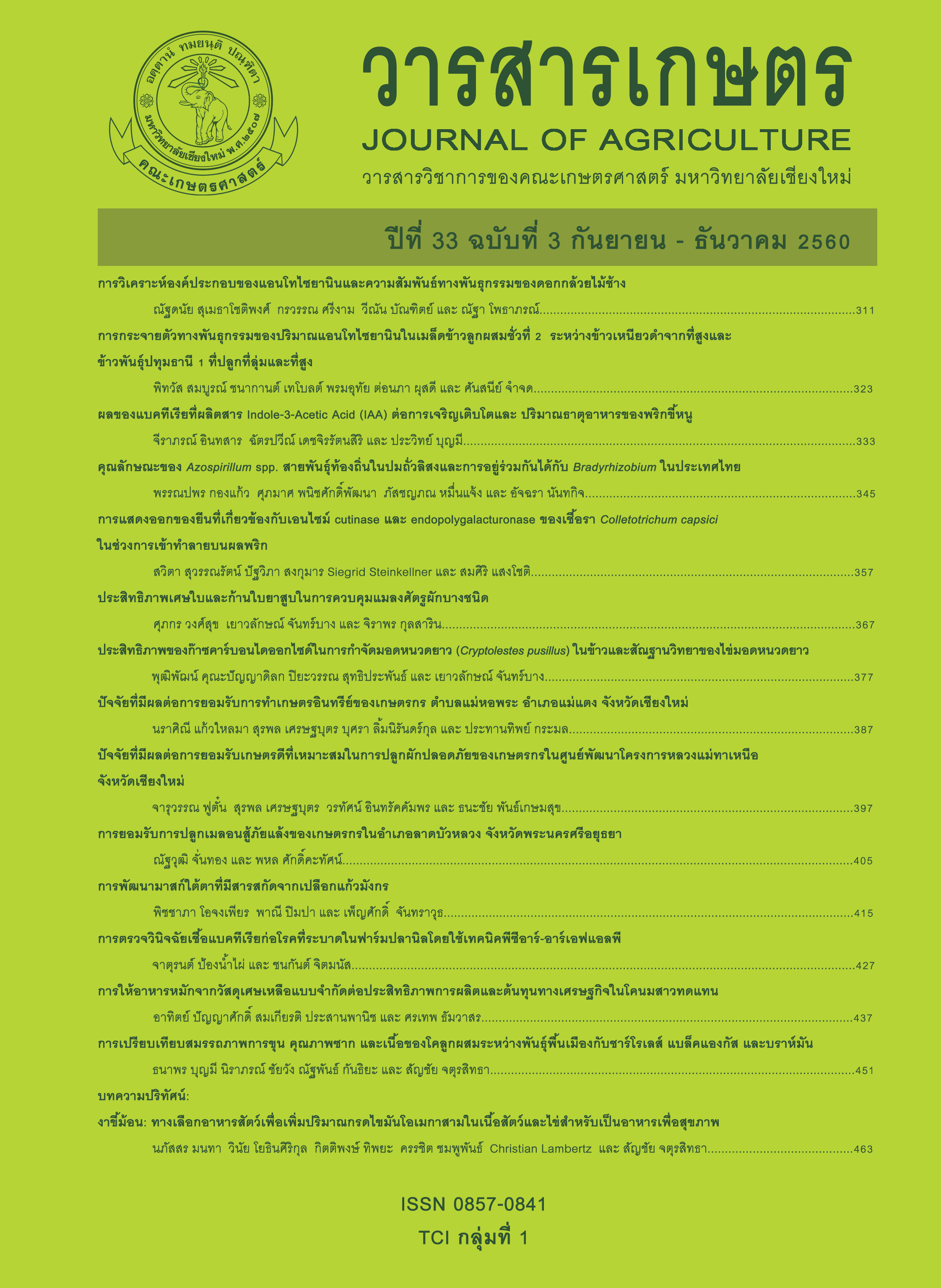การให้อาหารหมักจากวัสดุเศษเหลือแบบจำกัดต่อประสิทธิภาพการผลิต และต้นทุนทางเศรษฐกิจในโคนมสาวทดแทน
Main Article Content
บทคัดย่อ
การทดลองนี้ทำการศึกษาอิทธิพลของการให้อาหารหมักจากวัสดุเศษเหลือ (ensiled crop residue, ECR) แบบจำกัดต่อประสิทธิภาพการผลิต และผลตอบแทนทางเศรษฐกิจในโคนมสาวทดแทน โดยวางแผนการทดลองแบบสุ่มสมบูรณ์ ใช้โคนมสาวทดแทนพันธุ์ลูกผสมโฮสไตน์ฟรีเชี่ยน 87.50-93.25% เพศเมีย จำนวน 63 ตัว แบ่งเป็น 3 กลุ่ม ๆ ละ 3 ซ้ำ ๆ ละ 7 ตัว น้ำหนักเริ่มต้นเฉลี่ย 288.95 ± 10.54 กิโลกรัม และน้ำหนักสิ้นสุดเฉลี่ย 320.39 ± 3.11 กิโลกรัม ใช้เวลาตลอดการทดลอง 90 วัน โดยโคกลุ่มที่ 1 (ควบคุม) ได้รับเศษข้าวโพดหมัก ฟางข้าว และอาหารข้น (10, 3 และ 3 กิโลกรัม/ตัว/วัน) กลุ่มที่ 2 ได้รับ ECR ฟางข้าว และอาหารข้น (8, 2 และ 3 กิโลกรัม/ตัว/วัน) กลุ่มที่ 3 ได้รับ ECR และอาหารข้น (14 และ 2 กิโลกรัม/ตัว/วัน) ให้โคทั้งสามกลุ่มได้รับอาหารแบบจำกัดตามเงื่อนไขที่สหกรณ์กำหนด โคทุกตัวได้รับอาหารข้นที่มีระดับโปรตีน 14 เปอร์เซ็นต์ จากการศึกษาประสิทธิภาพการผลิต พบว่าการเปลี่ยนแปลงน้ำหนักตัวและอัตราการเจริญเติบโตเฉลี่ย ทั้งสามกลุ่มไม่ต่างกัน การเปลี่ยนแปลงคะแนนความสมบูรณ์ร่างกายของกลุ่มที่ 3 เท่ากับ 0.64 ± 0.03 มากกว่ากลุ่มที่ 1 และ 2 (P<0.01) ปริมาณวัตถุแห้งที่ได้รับทั้งหมดและปริมาณโปรตีนที่ได้รับ ในแต่ละกลุ่มแตกต่างกันอย่างมีนัยสำคัญยิ่งทางสถิติ (P<0.01) จากการศึกษาการย่อยได้ปรากฏของโภชนะ ในทุกกลุ่มไม่แตกต่างกัน แต่กลุ่มที่ 3 มีพลังงานย่อยได้ พลังงานที่ใช้ประโยชน์ได้ และโภชนะที่ย่อยได้ทั้งหมด สูงกว่าทั้งสองกลุ่ม (P>0.05) จากการศึกษาการเปลี่ยนแปลงทางชีวเคมีในเลือด พบว่ากลูโคสในเลือด ยูเรียไนโตรเจนในเลือด และฮอร์โมนไตรไอโอโดไทโรนีน มีค่าอยู่ในช่วงปกติ (P>0.05) จากการศึกษาต้นทุนทางเศรษฐกิจ พบว่าต้นทุนการผลิตทั้งหมดต่อตัวของทั้ง 3 กลุ่ม เท่ากับ 17,277.14 ± 59.20, 17,512.55 ± 59.49 และ 18,109.66 ± 58.89 บาท/ตัว (P<0.01) และต้นทุนการผลิตทั้งหมดต่อการเพิ่มน้ำหนักตัวในกลุ่มที่ 3 มีค่าต่ำกว่ากลุ่มที่ 2
Article Details
เอกสารอ้างอิง
ฉลอง วชิราภากร จันทิรา วงศ์เณร อนุสรณ์ เชิดทอง และกันยา พลแสน. 2559. ผลของกากเอทานอลแห้งในสูตรอาหารผสมสำเร็จต่อปริมาณการกินได้ การย่อยได้ ผลผลิตและองค์ประกอบน้ำนมในโคให้นม. วารสารเกษตร 32(2): 247-259.
ศรเทพ ธัมวาสร. 2550. คุณค่าทางอาหารของกากน้ำตาลเอทานอลและผลการทดลอง. หน้า 6-18. ใน: รายงานการสัมมนาพิเศษ เรื่อง การใช้กากน้ำตาลเอทานอลในการเลี้ยงสัตว์เพื่อลดต้นทุนการผลิต. มหาวิทยาลัยเกษตรศาสตร์, กรุงเทพฯ.
สุภาวดี แหยมคง. 2559. ต้นทุนและผลตอบแทนการผลิตโคเนื้อของเกษตรกรในอำเภอวัดโบสถ์ และอำเภอพรหมพิราม จังหวัดพิษณุโลก. วารสารเกษตร 32(3): 401-407.
AFFRCS. 1999. Japanese Feeding Standard for Dairy Cattle. Agriculture, Forestry and Fisheries Research Council Secretariat. Ministry of Agriculture, Forestry and Fisheries (MAFF), Japan.
Anderson, J., B.S. Capper and N.R. Bromage. 1991. Measurement and prediction of digestible energy value in feedstuffs for the herbivorous fish tilapia (Oreochromis niloticus Linn.). British Journal of Nutrition 66: 37-48.
Andrew, S.M., J.H. Clark and C.L. Davis. 1979. Feeding value of opaque-2 corn grain and corn silage for lactating dairy cows. Journal of Dairy Science 62: 1619-1625.
Association of Official Analytical Chemists (AOAC). 1984. Official Methods of Analysis of the Association of Official Analytical Chemists. 14th ed. AOAC, Arlington, VA.
Bolsen, K.K., C. Lin, B.E. Brent, A.M. Feyerherm, J.E. Urban and W.R. Aimutis. 1992. Effect of silage additive on the microbial succession and fermentation process of alfalfa and corn silage. Journal of Dairy Science 75: 3066-3083.
Chen, X.B. and M.J. Gomes. 1995. Estimation of Microbial Protein Supply to Sheep and Cattle Based on Urinary Excretion of Purine Derivatives-An Overview of the Technical Details. International Feed Resource Unit, Rowett Research Institute, Aberdeen.
Edmonson, A.J., I.J. Lean, L.D. Weaver, T. Farver and G. Webster. 1989. A body condition scoring chart for holstein dairy cows. Journal of Dairy Science 72: 68-78.
Elferink, S.J.W.H.O., F. Driehuis, J.C. Gottschal and S.F. Spoelstra. 2000. Silage fermentation processes and their manipulation, pp. 17-30. In: Proceedings of the FAO Electronic Conference on Tropical Silage. Plant Production and Protection, FAO. Rome.
Fenner, H. and J.M. Elliot. 1963. Quantitative method for determining the steam volatile fatty acids in rumen fluid by gas chromatography. Journal of Animal Science 22: 624-627.
Frandson, R.D., W.L. Willke and A.D. Fails. 2009. Anatomy and Physiology of Farm Animals. 7th ed. Wiley-Blackwell, Ames. 528 p.
Goering, H.K. and P.J. Van Soest. 1970. Forage Fiber Analyses (apparatus, reagents, procedures and some application). USDA Handbook Agricultural Research Service No. 379, Washington, D.C.
Guthrie, M.J. and D.G. Wagner. 1988. Influence of protein or grain supplementation and increasing levels of soybean meal on intake, utilization and passage rate of prairie hay in beef steers and heifers. Journal of Animal Science 66: 1529-1537.
Higginbotham, G.E., M. Torabi and J.T. Huber. 1989. Influence of dietary protein concentration and degradability on performance of lactating cows during hot environmental temperatures. Journal of Dairy Science 72: 2554-2564.
Khon, R. 2007. Use of milk or blood urea nitrogen to identify feed management inefficiencies and estimate nitrogen excretion by dairy cattle and other animals, pp. 1-15. In: Proceedings of Florida Ruminant Nutrition Symposium. Gainesville, FL. USA.
Leng, R.A. 1990. Factors affecting the utilization of poor quality forage by ruminants particularly under tropical conditions. Nutrition Research Reviews 3(1): 277-303.
McDonald, P., R.A. Edwards, J.F.D. Greenhalgh and C.A. Morgan. 2005. Animal Nutrition. 6th ed. Longman Scientific and Technical. New York.
Minson, D.J. 1990. Forage in Ruminant Nutrition. Academic Press, San Diego.
National Research Council (NRC). 2001. Nutrient Requirements of Dairy Cattle. 7th rev. ed. National Academy Press, Washington, D.C. 408 p.
Park, R.S., and M.D. Stronge. 2005. Silage Production and Utilisation. Wageningen Academic Publishers, Wageningen. 288 p.
Promma, S., S. Tuikumpee, P. Jeenklum and T. Indratula. 1993. Effect of varying dietary levels of total digestible nutrients, protein and fiber on the growth of crossbred holstein heifers fed urea-treated rice straw diets under two feeding systems. Asian-Australasian Journal of Animal Sciences 6(1): 91-97.
Riis, P.M. 1983. Dynamic Biochemistry of Animal Production. Elsevier Science, Amsterdam.
Schmid, M. and V. Forstner. 1986. Laboratory Testing in Veterinary Medicine Diagnosis and Clinical Monitoring. 3rd ed. Boehringer Mannheim, Mannheim. 253 p.
Singh, A.S., D.T. Pal, B.C. Mandal, P. Singh and N.N. Pathak. 2002. Studies on changes in some of blood constituents of adult crossbred cattle fed different levels of extracted rice bran. Paksitan. Journal of Nutrition 1(2): 95-98.
Steel, R.G.D. and J.H. Torrie. 1980. Principles and Procedures of Statistics: A Biometrical Approach. 2nd ed. McGraw-Hill, Aucklan.
Tiffany, T.O., J.M. Jansen, C.A. Burtis, J.B. Overton and C.D. Scott. 1972. Enzymatic kinetic rate and end point analyses of substrate by the use of a GeMSAEC fast analyzer. Clinical Chemistry 18(8): 829-840.
Tumwasorn, S., P. Climee, W. Pirunsarn, B. Chompoosri and S. Sritawee. 1996. Production of silage from sweet corn waste for small farm dairy cattle operation. Thai Journal of Agricultural Science 29(4): 595-601.
Van Keulen, J. and B.A. Young. 1977. Evaliation of acid insoluble ash as a natural marker in ruminant digestibility studies. Journal of Animal Science 44: 282-287.
Van Soest, P.J. 1987. Nutritional Ecology of the Ruminant: Ruminant Metabolism, Nutritional Strategies, the Cellulolytic Fermentation and the Chemistry of Forage and Plant Fiber. Cornell University Press, Ithaca.
Waltner S.S., J.P. McNamara and J.K. Hillers. 1993. Relationships of body condition score to production variables in high producing holstein dairy cattle. Journal of Dairy Science 76: 3410-3419.
Wheeler, J.L. and C. Mulcahy. 1989. Consequences for animal production of cyanogenesis in sorghum and hay. Tropical Grasslands 23: 193-202.


